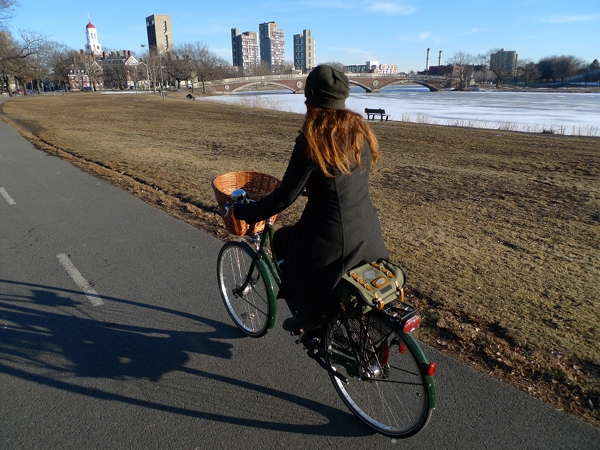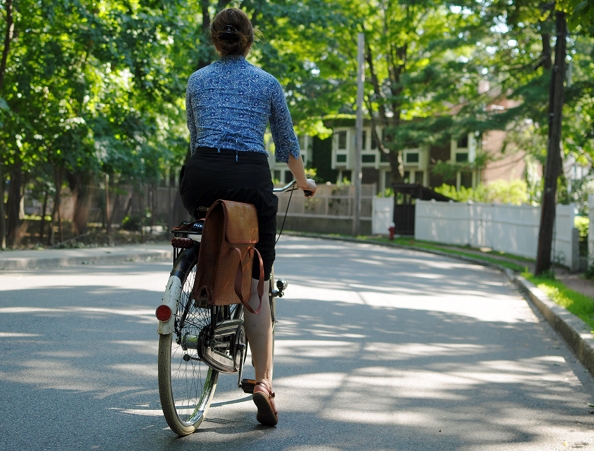Lately, there has been some discussion in the comments about whether drivers display more courtesy when cyclists ride upright bicycles and dress in "regular" clothing. One reader wrote that "the uprightness [is] more visible and [the clothing] maybe less offensive to your average driver... The images generated revolve around Mary Poppins. Only a monster would do anything mean to Mary Poppins" (Christopher Fotos, December 10, 2010). Do you agree?
When Bike Snob NYC poked fun at the Tweed Ride last week in his typically colourful manner, I was laughing my head off about the associations with colonialism and Civil War re-enactments: I never found Tweed Rides appealing for precisely those reasons. But I disagree with his conclusion that nice clothes on a bike are generally "not traffic calming." It's one thing to be dressed in what appears to be period costume, joined by dozens of others who have done the same while taking a joyride through the city. It's another thing entirely to be cycling to work in a suit and a wool overcoat, because that is what you normally wear to work.
Speaking solely from my own experience, I'd noticed as soon as I started cycling for transportation that drivers are nicer to me when I dress "normally." And since having begun to ride a roadbike recreationally, the difference between how I am treated on the roads when on a bike with drop bars, wearing "sporty clothing" and my hair tucked away, in comparison to how I am treated when on an upright bike in "city clothing," with my work bag in the basket and my hair visible, is notable. The majority of the time, when a driver is rude to me or impatient with me, I am on my roadbike - which is odd, since I am faster on a roadbike than I am on an upright bike, and thus should be less "in the way." To me, this just confirms that drivers' perceptions of how annoying a cyclist is, are entirely subjective. You can be going 10mph and somehow this might be okay, or you can be going 25mph and they might still be annoyed.
In part, I think the idea of not wanting to harm Mary Poppins is valid - in the sense that a cyclist dressed "normally" looks more human to the driver. The way people process each other visually and emotionally is governed by a complicated system of simulation and self-recognition (this is actually my research specialty, so I've spent a lot of time thinking about it!). And from that point of view, it makes sense to speculate that the more "I am human! I am you!" signals we give off when cycling, the more empathy a driver will feel towards us. Dehumanisation, on the other hand, makes it easier to cause harm to another human being - because we fail to simulate their emotional state and relate to their suffering. And dehumanisation is facilitated by things like uniforms (one reason it is easier to kill soldiers and war prisoners, than civilians), or anything else that obscures individuality and hides signs of "humanness".
But in addition to the Mary Poppins effect, I think that there are also implicit "right of way" rules that are present in the driver's mentality, from which "normally" dressed cyclists benefit. I am not suggesting that this is right or justified in any way, but I get the impression that drivers are enraged by the associations with leisure and recreation that a road cyclist's attire evokes. The cyclist is on the road because they are "going for a ride." The driver, however, is on the road because they "need to be somewhere." So the reasoning follows, that the person who needs to be somewhere clearly has more valid reasons to use the limited road space than the person who is going for a ride, which is why the presence of the road cyclist causes annoyance. On the other hand, when the cyclist's appearance suggests that they are also engaging in transportation and "need to be somewhere" just like the driver, their presence on the roads seems more justified. This is just a theory, but the fact that drivers will shout things like "Get a job!" to roadies, but will ask me "How long does it take you to get to work?" at red lights when I am dressed up, gives it some plausibility. They associate the "normal clothes" look with going to work, and they associate the sporty look with recreation.
All of this is, of course, entirely speculative and none of it is to say that cyclists should strive to dress in any particular way in order to secure the driver's compassion. Only the certainty of criminal prosecution can reliably deter a driver from causing harm to a cyclist, and I hope to see that become the norm in the US in the near future. Until then, let's hope that drivers can find a way to see Mary Poppins in all of us, whether we are dressed in lycra, tweed, or something in between.
Monday, January 10, 2011
Subscribe to:
Post Comments (Atom)
Blog Archive
-
▼
2011
(631)
-
▼
January
(213)
- Comments, Arguments, Bicycles...
- 1910 Model 3 1/2 Norton
- Where Have You Been...
- The Trading Post
- 1929 Model 18 Norton
- Barter Economy
- Stop, Look Around...
- Racking Your Brain!
- Tucker wins the 1929 200 mile sidecar race
- Who's Afraid of Toe Overlap?
- Regular Wool vs 'Technical' Wool
- Getting a Custom Bicycle, Part II: Choosing a Fram...
- Motors To The Rest of World War II
- Chavez also lambasted Toyota
- A Government Soldier Killed
- A worker Waits As Goods
- Hugo Chavez Greets Supporters
- Hugo Chávez Rides The Atomic Bicycle
- Motor Suzuki Skydrive Dynamatic 125 cc reviews
- Bajaj Pulsar 135 LS (Light Sport) SOHC DTS-i Reviews
- Bajaj Pulsar Fairing Motorcycles Pics
- yamaha motorcycle R1 magnificent
- girl and yamaha motorcyle R1
- Superba Colour and Other Decisions: Your Feedback ...
- Andrew's 1910 Big Four Norton
- The Least Daunting Option
- Lugwork Preferences
- CS1 flat tank Norton
- What Do Bike Shops Want to Sell You, and Why?
- Bicycle Portraits in Ambrotype and Tintype
- Gas Moped Scooter
- Showing Off or Showing How? On Bicycle Blog Exhibi...
- Lean and mean: the Icare motorcycle concept will t...
- A Lovely Touring Bike... For You?
- 1925 Model 18 Norton
- Brooks Colt: New vs Vintage
- Two Wheeled Tweets
- Sturmey Archer positive stop mechanisms
- tron motorcycle
- The Case of the Disappearing Bike Lanes
- On Bicycle Maintenance and Limitations
- Peter's Model 19 Norton
- A Functional Blizzard
- Domesticating the Transportation Bicycle?
- 1929 Model 18 Norton
- The Anthology Of Motorcycle
- Older Issue Of Motor Cycling
- Motorcycle Pin-Up Girl Giclee
- Kaiser Bill's Car
- King George III
- Riding Car - The First Petroleum Powered Vehicle
- Motorcycles For Military and Police
- Liberty Cadillac - 1918
- 1970 Opel GT
- Rolls-Royce Silver
- Buick Limited
- A Porsche Speedster
- Pre-War Antique Car
- 1948 Ford Super Deluxe
- Rare 1970 Dodge Challenger R/T SE in Panther Pink
- 1912 McIntyre
- 1934 Graham convertible
- Dream Car Garage
- 1959 Austin-Healey Sprite
- When President Kennedy Was Shot
- The Classic Greek Tragedy
- Mass Panic at German Music Festival
- US can't seal Afghan-Pakistan border
- A Fun Thing For Both Boys
- Evacuation of injured South Vietnamese
- Keeping His Little Sister
- Extricate Wounded Civilians
- The Bella Ciao 'Superba' - My Take on the Italian ...
- The Mary Poppins Effect?
- 1927 Model 18 Norton
- Bicycle Trainers and Winter Withdrawal
- Fotos de el Che Guevara
- On the road to revolution - the ‘back story’ to Er...
- The Award of Posthumous Membership of the NACC to ...
- British Bikers Following Che Guevara’s Tracks
- The children of former president Ferdinand Marcos
- Ferdinand Marcos’ Restless Corpse
- John F. Kennedy's Lincoln Presidential Limousine
- Argentine president Nestor Kirchner In The Car
- President Ferdinand Marcos and his wife Imelda
- Administrative assistant in Cal State San Marcos P...
- Armored 1988 Mercedes-Benz 500 SEL - car president...
- The Iron Man - Sardar Patel
- Architect of Modern India - Jawaharlal Nehru
- Jawaharlal Nehru In The Car
- Former Wife of Sukarno with New Husband
- Dewi Sukarno and Her Daughter
- Dewi Sukarno Admiring Her Infant
- Madame Sukarno Having Hair Done
- Sukarno at Disneyland
- President Kenendy and Indonesian President Sukarno...
- President Kennedy Greets President Sukarno
- Achmed Sukarno Waving from His Limousine
- John Kennedy Inspecting Soldiers
- President Kennedy and Indonesia's President Sukarn...
-
▼
January
(213)



0 comments:
Post a Comment